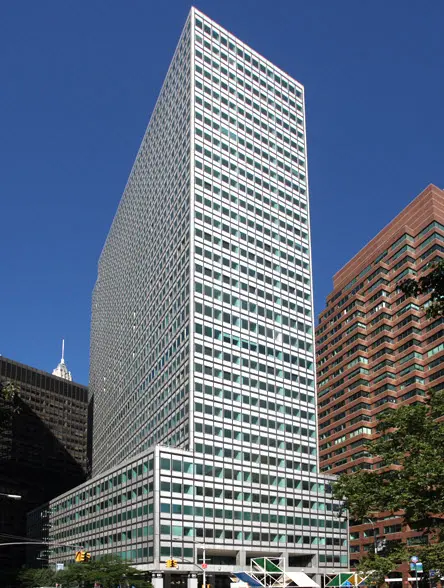200 Water Street: Review and Ratings
between Fulton Street & John Street View Full Building Profile


Robert and Melvyn Kaufman of the William Kaufman Organization erected many office buildings in the 1960s, 1970s and 1980s that were unusual. Three of them are modern landmarks in Lower Manhattan: this building, 77 Water Street and 17 State Street.
This 32-story building was erected in 1971 and its design by Emery Roth & Sons and by Corchia-de Harak Assocs., headed by Rudi de Harak, shocked the real estate community for it was a very sleek modern and clean-cut office building whose entrance on Water Street was through a very large corrugated steel, neon-lit tunnel and whose entrance on Fulton Street was cascading canvas canopies. In addition, it featured the world s largest digital clock on its Water Street base.
As the most prominent building at the entrance to the South Street Seaport, it was hard not to notice and it caused even more of a stir than the other Kaufman building on Water Street, 77 Water Street, which was very notable for its open lobby with wooden-front general store fronting on a meandering stream lined with day-glo love-seats with bright plastic backs in the form of giant twiddly-winks. That building's crowning glory, of course, was a full-size sculpture of a Sopwith Camel fighter plane (World War I vintage) on an Astroturf runway replete with windsock.
Several years later, the Kaufmans broke with their own tradition and had Richard Roth of Emery Roth & Sons design an office building facing the Statue of Liberty at 17 State Street with a reflective-glass curved façade and a glass lobby surrounded by cobblestones. It is the city's, and perhaps the world's, most beautiful reflective-glass building.
Melvyn Kaufman, the feisty, irascible, and delightful philosopher-developer of the two brothers, believed vehemently that buildings should do something for the public.
In 1997, the Rockrose Development Corporation took over the office building at 127 John Street and converted it to 576 residential apartments and in the process changed its address to 200 Water Street. It is also known as 32-38 Fulton Street and 240-266 Pearl Street.
The city enacted zoning changes in the late 1990s to encourage residential conversions in the area.
The John Street area was for many years known as an important insurance company enclave. Rockrose also converted 99 John Street, which once housed part of AIG Insurance, to apartments. WSA Equities of Garden City, L.I., converted 80 John Street, a former Travelers Insurance property, to a 147-unit rental.
127 John Street had housed Prudential Securities when it was an office building but when the bank consortium that held the mortgage on it took it back when the market faltered, Rockrose acquired the leasehold in 1996 for $5 million.
According to an article in the April 6, 1997 edition of The New York Times by Alan Oser, the $80 million conversion by Rockrose was "the first in New York in which a first-class postwar office building has been converted to purely residential use (though with street-level stores)."
The base was converted to about 100 duplex apartments of about 1,800 square feet, with living rooms two stories high. Avinash K. Malhotra noted in Mr. Oser's article that "Eight elevators will serve the 576 apartments...That is three more than would probably have been used in a new building of similar size designed for residential use."
The article noted that the curtainwall façade of the building was retained but modified to provide operable windows and it quoted Mr. Malhotra as saying that "It's rare to have an apartment house with a curtainwall façade because it's usually much too expensive."
"The Kaufmans," Mr. Oser observed, "were known for unusual, highly contemporary aesthetics on their properties, and 127 John Street was no exception. The lighting designer Howard Branston went to court on behalf of himself and other designers to try to assure preservation of some of those elements. 'It was a public amenity, and the developer was given a floor-area bonus on the basis of the plaza design,' Mr. Branston said. The case was eventually settled, with Rockrose agreeing to preserve some elements, although not the unusual galvanized sheet metal neon-lit tunnel through which pedestrians entered the lobby of 127 John."
The building became known as NYU at the Seaport and was used as a student dormitory, but in the summer of 2009 Rockrose decided to reconvert the property to rental apartments.
 6sqft delivers the latest on real estate, architecture, and design, straight from New York City.
6sqft delivers the latest on real estate, architecture, and design, straight from New York City.
